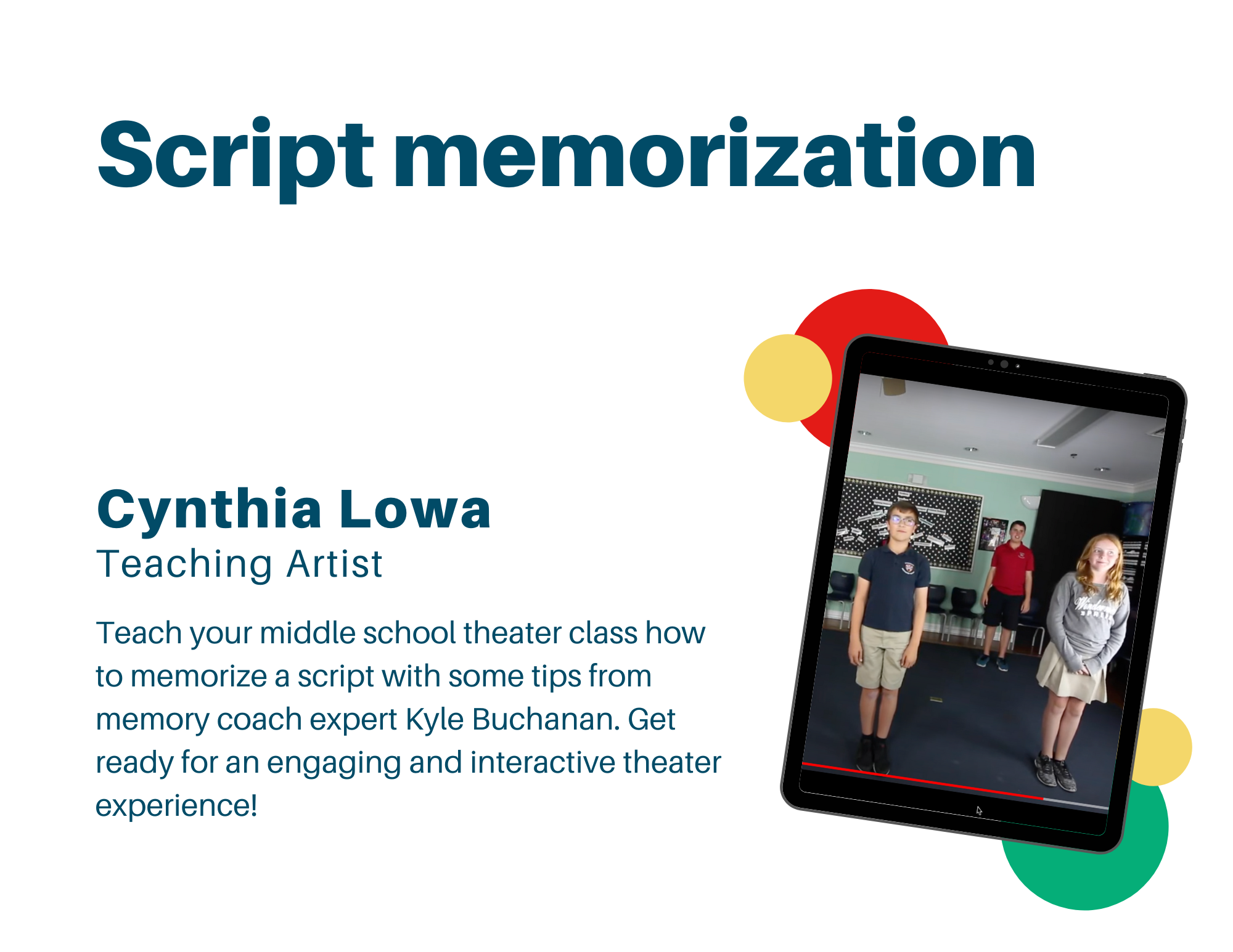How do actors memorize their lines
Ever struggled with the “how do actors memorize their lines” question? Show your middle school theater class some tips from memory coach expert Kyle Buchanan in this unit inspired by memorization expert Kyle Buchanan. Our script memorization unit is part of the The Lion, the Witch, and the Wardrobe Play curriculum kit, but it can be used as a stand alone unit for a middle school theater class session.
Meet Teaching Artist, Director, Writer and Actress Cynthia Lowa
Cynthia Lowa has taught acting and voice at Windermere Preparatory School, University of Central Florida, The Children’s Theatre of Florida, the New York Film Academy at Disney/MGM Studios, and other Orlando studios for more than ten years. She has directed multiple productions including Dear Edwina, Starmites, Tom Sawyer, The Rockin’ Tale of Snow White, Peter Pan and Wendy, Shrek the Musical, Murder at the Banquet, Nobody to Murder, and Lion King, Jr., A Broadway Musical Revue; The Lion, The Witch, and The Wardrobe, and others! CreateTruthAlive.com
Script memorization
Video curriculum:
- Teaching Artist Bio
- Script memorization
Drama Lesson Plans for Middle School include:
- Editable Google Slides
- Self Grading Google Form
- National Art and Common Core Standards
- Summative and Formative Assessments
Teaching apps and tech tutorials:
- SeeSaw
- Kahoot
- FlipGrid
- Self Grading Google Form
Get paid to test out our middle school drama teaching resources
Become a member to access theater curriculum kits FREE through DonorsChoose. Membership opens twice a year. You can join a Focus Group year-round and get paid to test out our resources. Get on the waitlist today!
The Lion, the Witch, and the Wardrobe Play: Script Memorization
Watch Cynthia Lowa’s teaching session on script memorization which is one of the sessions in the Lion, the Witch, and the Wardrobe Play curriculum kit.
Script Memorization Video Transcript
How do actors memorize their lines video transcript
Memorizing the script is a huge task for new and mature actors. So in this session, I want to introduce you to an expert on the topic…Kyle Buchanan is the world’s most watched memory coach and the creator of Memorize Academy. His videos have been viewed over 6 million times across YouTube and other platforms. He has pioneered the use of whiteboard animation videos to teach best-practice memorization techniques to students and lifelong learners around the world.
So whether it’s studying for a test at school or memorizing the script for a play, the five memorization techniques he gives are guaranteed to help you memorize in half the time. Throughout this session, we’ll discuss and apply these memorization principles to the Prologue of the play.
1. The first principle to swift memorization is meaningfulness.
Things that make sense to you are easier to learn than those that don’t. Existing information you have on a topic makes it easier for you to remember new information on that same topic. All of the time and effort you put into the character analysis gives your brain a context, a setting, a familiarity with the characters in such a way that their words and dialogue make more sense to your brain.
What do you know about the context?
[Answers are relevant for The Lion, the Witch, and the Wardrobe play script.]
So based on your character analysis, you know that the setting for the prologue is a professor’s mansion which is located in the countryside of England. They were sent their to avoid the World War II air raids. That’s the information you already know and understand before you start memorizing the lines.
What do you know about the characters?
You also know about each of the children. Susan is very motherly, Peter is very protective, Edmund loves to complain, and Lucy loves to explore. Everything you know about the setting and the characters provides meaning for the script so that the lines can make sense to you.
Create meaningfulness by blocking out the scene as you rehearse.
Another technique that can help create meaningfulness is to actually block out the scene as you recite your lines. Whether it’s your bedroom, the living room, or your backyard, you can create the space of the scene in your mind and move around in it as though all of the other characters were there. This hands-on technique will make a meaningful context in your mind and reinforce the memory process.
2. The second principle is organization.
Information needs to be well organized to be easily accessible for your brain. Sequences and categories help your brain organize information effectively. You could create a sequence that shows where the children plan to explore in the mansion.
Sequences help actors memorize their lines.
[Sequence 1: Front of window]
The children start the scene talking in front of a window,
[Sequence 2: Peter>sword room]
then Peter suggests going to the sword room
[Sequence 3. Susan> library]
Susan walks to the library
[Sequence 4. Lucy> wardrobe room]
And Lucy walks towards the room with the wardrobe.
[Sequence 5. Edmund> outside]
Of course Edmund doesn’t like any of their ideas and just wants to go outside.
Categories help actors memorize their lines.
You could also categorize ideas under each character based on how they feel about the mansion and where they want to go.
Categories for Susan
Susan’s first line is “What an exciting old mansion!” so we would put “exciting” under her name. Then she says she’s going to love staying in the mansion, so we add that. The place she wants to go is the library, and we have three ideas all under the category of Susan.
[Susan> exciting, loves mansion, library]
Categories for Edmund
Edmund is the next one to speak, and of course he has to contradict his sister Susan using the opposite of her word “exciting” because he thinks the mansion is “boring.” Then he has to criticize Lucy’s idea of going into the rom with the wardrobe because he believes there’s “nothing in it.” Lastly, he states that he wants to do the only thing he can’t do because it’s raining–and that is to go outside. Good ole Edmund!
[Edmund> boring, nothing in it, outside]
Categories for Peter
Peter starts by trying to convince Edmund that the mansion will be a fun place to explore. Then he mimics the housekeeper, “Stay out of my way!” Finally, he invites Edmund to go with him to the sword room, keeping with his masculine, adventuresome personality.
[Peter> fun, housekeeper, sword room]
Categories for Lucy
Lucy agrees with both Lucy and Susan that the mansion is an interesting place to explore. And she’s pretty fascinated by the largest wardrobe she has ever seen.
[Lucy> interesting, wardrobe room]
Creating these categories helps our brains to organize the information which in turn helps us to memorize lines with speed.
3. The third principle is association.
Association helps you connect new information to information you already know. This links back to the principle of meaningfulness because the more associated information you have, the more meaningful it is.
You can use association with script memory by associating characters in the play with people you know well…or your favorite book character or movie actor. Maybe Edmund reminds you of your cousin who’s always complaining and feeling sorry for himself or the White Witch with Cruella Deville from 101 Dalmations. The key is to associate the character with another person or character you know well who truly matches the character in the play. If you find a good match, you may even find yourself imitating the way that person walks or speaks when you say your lines.
4. The fourth principle is visualization.
This tool is my favorite because research shows that visuals are more than twice as effective as text when it comes to memory retention.
So as you recite your lines, create a visual image or video for every line. Visualize yourself as the character in the scene or be the observer watching someone else play your character in the scene while you recite the lines. If you’re an artist, you may want to sketch out a storyboard for each line. If not, maybe you can download an image for each line. Otherwise, you can wield the power of your imagination to create visual images in your mind that will guide you from one line to the next.
5. The fifth and last principle is attention.
Focus on one thing at a time. Don’t try to memorize your lines while you’re watching your favorite tv show. This cuts your ability to remember in half.
As you implement these memorization principles, I strongly encourage you to use technology to your advantage. Use your smartphone’s audio recorder or an Internet app to record your lines. If necessary, break the scene up into sections so you aren’t recording more than three minutes at a time. As you record, read the whole script–don’t skip the other characters’ lines because their lines will help you remember what to say next.
How do you memorize with the recording?
Once you have recorded the audio, you can play it back over and over again reciting your lines out loud with the audio track. Practice each audio track until you’ve mastered it, and then move on to the next. Once you’ve got the second track memorized, go back and review the first and then the second before moving on to the third track.
How does a recording help?
This will enable you to use the principles of organization–specifically sequence–and association to your advantage. You can also just say all the other character’s lines and be quiet for a few seconds where you would speak your lines. Then, you can really practice like you were actually in a rehearsal or performance!
Thanks to Kyle Buchanan for these amazing memorization techniques. Be sure to check out his memorization courses online.






